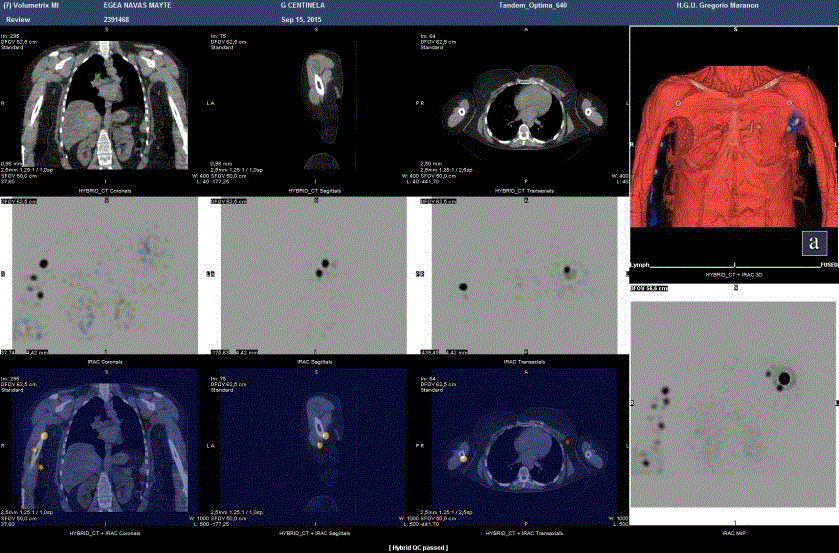Clinical Image
Lymphoscintigraphy and SPECT-CT Imaging: An Effective Method to Evaluate Surgical Outcomes in Lymphedema Surgery
Jose M Lasso*, Esther Deleyto and Michele Castellano
Department of Plastic and Reconstructive Surgery, Hospital General Universitario Gregorio Marañón, Madrid,
Spain
*Corresponding author: Jose M Lasso, Department of Plastic and Reconstructive Surgery, Hospital General Universitario Gregorio Marañón, Madrid, Spain
Published: 27 Sep, 2017
Cite this article as: Lasso JM, Deleyto E, Castellano M.
Lymphoscintigraphy and SPECTCT
Imaging: An Effective Method
to Evaluate Surgical Outcomes in
Lymphedema Surgery. Clin Surg. 2017;
2: 1640.
Clinical Image
Lymphoscintigraphy is the standardized tool for the evaluation of limb lymphedema, it is the
generalized imaging technique used for its diagnosis and classification and also for pre-surgical
planning [1-4].
Lymphoscintigraphy is a specific, simple and reliable technique that offers useful information
of lymphatic function, allowing the examiner to detect lymphatic flow obstructions, dilated vessels,
collateral lymphatic flow and the presence, malfunction or absence of lymph nodes. Dermal
activity uptake is a fundamental finding related to lymphedema [5,6]. However, conventional
lymphoscintigraphy has limitations related to its two-dimensional view, which does not allow a
detailed spatial localization of tracer accumulation. Also, it cannot interpret secondary changes in
connective-tissue such as fibrosis, nor can it accurately distinguish between dermal backflow and
deeper lymph vessel accumulation [7].
SPECT-CT is currently used with lymphoscintigraphy for sentinel node detection in breast
cancer [8]. In lymphedema, combined SPECT-CT/lymphography systems provide integrated
functional and morphological information, allowing a better localization in depth of vessels and
lymph nodes, an accurate distinction between lymph vessels and veins and a correct interpretation
of dermal backflow [9].
Combined CT-imaging has allowed a better comprehension of the physiopathology of
lymphedema and many studies have proposed taking SECT-CT imaging beyond diagnosis reported
its value also in microsurgical treatment. The incorporation of SPECT-CT in lymphedema staging
might prove useful to predict treatment efficacy [10-12].
At our center, combined lymphoscintigraphy and SPECT-CT
imaging is used routinely in all patients that are eligible for surgical
treatment of limb lymphedema. Images are obtained before surgery,
for diagnosis, evaluation and treatment planning – and 1 year after
the procedure. Studying all pre and postsurgical images obtained
to the date, we have been able, as well as to classify the disease and
decide the optimal treatment, to relate clinical outcomes to anatomic
and functional images.
For patients who present with limb lymphedema secondary to
surgical lymphadenectomy clinically classified as stages III or IV
and with SPECT-lymphography imaging that suggests absence of
functioning lymph nodes associated to dermal backflow patterns, we
propose microsurgical lymph node transfer. Surgery is followed by a
course of progressive bandaging and physiotherapy.
Image 1 shows the postoperative findings of a secondary
lymphedema of the right upper limb one year after a right breast
reconstruction with simultaneous lymph node transfer (a composite
free flap with two microvascular pedicles, DIEP flap and superficial
groin nodes). We can observe on the left axilla a group of lymph nodes,
on the other hand, at the right arm there are several lymph nodes
along the arm and blue marks corresponding to functional lymphatic
vessels. Preoperative lymphography showed abolished activity of
the lymphatic system of the right upper limb. Lymph node transfer
activated the lymphatic flow which was abolished after the breast
cancer surgery; this fact was confirmed clinically and objectively.
Our aim is to correlate clinical outcomes with SPECTlymphography
imaging findings and to compare them with the
preoperative images, therefore being able to study our results based
on technique and stage of lymphedema, to choose the best surgical
option for every patient and to predict results after surgery.
Image 1
References
- Szuba A, Shin WS, Strauss HW, Rockson S. The third circulation: radionuclide lymphoscintigraphy in the evaluation of lymphedema. J Nucl Med. 2003;44:43-57.
- Williams WH, Witte Cl, Witte MH, McNeill GC. Radionuclide lymphangioscintigraphy in the evaluation of peripheral lymphedema. Clin Nucl Med. 2000;25:451-64.
- Yamamoto T, Narushima M, Doi K, Oshima A, Ogata F, Mihara M, et al. Characteristic indocyanine green lymphography findings in lower extremity lymphedema: the generation of a novel lymphedema severity staging system using dermal backflow patterns. Plast Reconstr Surg. 2011;127(5):1979-86.
- Maegawa K, Miami T, Yamamoto Y, Satake T, Kobayashi S. Types of lymphoscintigraphy and indications for lymphaticovenous anastomosis. Microsurgery. 2010;30:437-42.
- Witte CL, Witte MH, Unger EC, Williams WH, Bernas MJ, McNeill GC, et al. Advances in imaging of lymph flow disorders. Radiographics. 2000;20:1697-19.
- International Society of Lymphology. The diagnosis and treatment of peripherallymphedema: 2013 Consensus Document of the International Society of Lymphology. Lymphology. 2013;46:106-19.
- Baulieu F, Bourgeois P, Maruani A, J.P. Belgrado, V. Tauveron, G. Lorette, et al. Contributions of SPECT/CT imaging to the lymphoscintigraphic investigations of the lower limb lymphedema. Lymphology. 2013;46(3):106-19.
- Cheville AL, Brinkmann DH, Ward SB, Jolanta Durski, Laack NN, Elizabeth Yan, et al. The addition of SPECT/CT lymphoscintigraphy to breast cancer radiation planning spares lymph nodes critical for arm drainage. Intl J Rad Onc Bio Phys. 2013;85(4):971-7.
- Iimura T, Fukushima Y, Kumita S, Rei Ogawa, Hiko Hyakusoku. Estimating Lymphodynamic Conditions and Lymphovenous Anastomosis Efficacy Using 99mTc-phytate Lymphoscintigraphy with SPECT-CT in Patients with Lower-limb Lymphedema. Plast Reconstr Surg Glob Open. 2015;3(5): e404.
- Weiss M, Baumeister RG, Frick A, Jens Wallmichrath, Peter Bartenstein, Axel Rominger. Primary Lymphedema of the Lower Limb: The Clinical Utility of Single Photon Emission Computed Tomography/CT. Korean journal of radiology. 2015;16(1):188-95.
- Pecking AP, Albérini JL, Wartski M, Edeline V, Cluzan RV. Relationship between lymphoscintigraphy and clinical findings in lower limblymphedema (LO): toward a comprehensive staging. Lymphology. 2008;41(1):1-10.
- Campisi C, Boccardo F. Microsurgical technique for lymphedema treatment: Derivative lymphatic-venous microsurgery. World J Surg. 2004;28:609-13.

